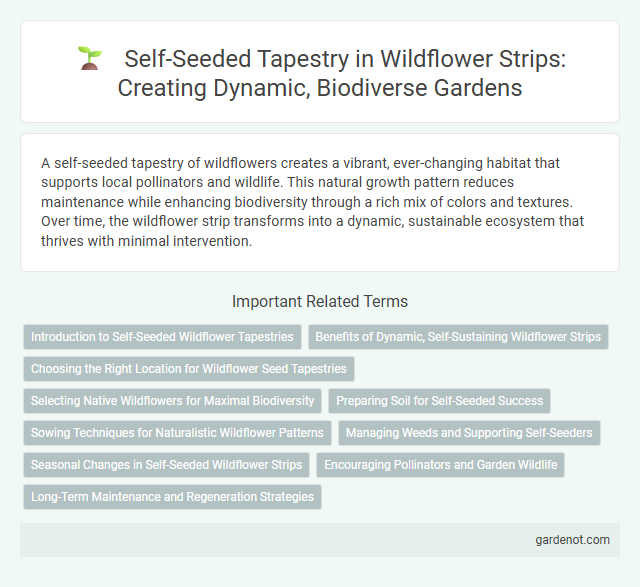A self-seeded tapestry of wildflowers creates a vibrant, ever-changing habitat that supports local pollinators and wildlife. This natural growth pattern reduces maintenance while enhancing biodiversity through a rich mix of colors and textures. Over time, the wildflower strip transforms into a dynamic, sustainable ecosystem that thrives with minimal intervention.
Introduction to Self-Seeded Wildflower Tapestries
Self-seeded wildflower tapestries create vibrant, natural landscapes by allowing native wildflowers to propagate autonomously, enhancing biodiversity and ecosystem resilience. These tapestries foster pollinator habitats and promote soil health through diverse plant species that naturally reseed each season. Implementing self-seeded wildflower strips reduces maintenance efforts while supporting sustainable environmental stewardship.
Benefits of Dynamic, Self-Sustaining Wildflower Strips
Self-seeded wildflower strips create dynamic, self-sustaining tapestries that enhance biodiversity by providing continuous habitats and food sources for pollinators and beneficial insects. These strips reduce maintenance efforts and costs since they naturally regenerate each season, adapting to local soil and climate conditions. The ecological balance established by self-seeded wildflowers supports soil health and improves ecosystem resilience, promoting sustainable land management practices.
Choosing the Right Location for Wildflower Seed Tapestries
Selecting the ideal location for a self-seeded wildflower seed tapestry requires assessing soil quality, sunlight exposure, and drainage conditions to ensure optimal growth and biodiversity. A well-drained site with full to partial sunlight promotes vigorous germination and supports a diverse range of native wildflower species. Avoid heavy shade or waterlogged areas to enhance seed establishment and create a thriving, sustainable wildflower habitat.
Selecting Native Wildflowers for Maximal Biodiversity
Selecting native wildflowers such as Echinacea purpurea, Asclepias tuberosa, and Solidago canadensis promotes a self-seeded tapestry that maximizes biodiversity by providing essential resources for pollinators and soil health. These species are well-adapted to local conditions, ensuring sustainability and minimal maintenance while supporting a diverse range of insects and bird species. Incorporating a variety of blooming periods enhances continuous habitat availability, fostering ecological resilience throughout the growing season.
Preparing Soil for Self-Seeded Success
Preparing soil for a self-seeded wildflower strip involves creating a nutrient-poor, well-draining environment to encourage native wildflower germination and growth. Removing existing vegetation and lightly tilling the soil promotes better seed-to-soil contact while minimizing competition from aggressive plants. Ensuring the soil is free from fertilizers and organic-rich amendments supports the establishment of a self-sustaining, diverse flowering tapestry.
Sowing Techniques for Naturalistic Wildflower Patterns
Self-seeded tapestry wildflower strips thrive when using selective sowing techniques that mimic natural seed dispersal patterns, promoting biodiversity and resilient ecosystems. Scattering seed mixes of native species in irregular clusters and varying densities encourages spontaneous germination and diverse plant layering, replicating natural meadow dynamics. Incorporating seasonal timing aligned with local climatic conditions ensures optimal germination, establishing a sustainable and visually appealing wildflower mosaic.
Managing Weeds and Supporting Self-Seeders
Managing weeds in a self-seeded wildflower strip requires regular monitoring and selective removal to prevent invasive species from outcompeting native blooms. Supporting self-seeders involves minimal disturbance of soil, allowing natural reseeding cycles to maintain floral diversity and ecosystem resilience. Integrating organic mulch can suppress weed growth while enhancing moisture retention for emerging wildflowers.
Seasonal Changes in Self-Seeded Wildflower Strips
Seasonal changes in self-seeded wildflower strips create dynamic natural tapestries with varying colors, textures, and bloom cycles that support diverse pollinators throughout the year. Early spring usually features bright primroses and violets, while summer brings vibrant poppies and cornflowers, and autumn highlights asters and goldenrods. The continuous self-seeding process ensures plant diversity and habitat renewal, maintaining ecological resilience and aesthetic appeal across seasons.
Encouraging Pollinators and Garden Wildlife
Self-seeded wildflower strips create a natural tapestry that supports pollinators by providing continuous blooms throughout the growing season. Native wildflowers like coneflowers, black-eyed Susans, and milkweed attract bees, butterflies, and other beneficial insects, enhancing biodiversity and garden health. These habitats also offer shelter and food for birds and small wildlife, fostering a balanced ecosystem.
Long-Term Maintenance and Regeneration Strategies
Self-seeded wildflower strips develop resilient plant communities that require minimal intervention, relying on natural regeneration through seed dispersal and germination cycles. Long-term maintenance involves periodic monitoring of species composition to prevent dominance by aggressive plants and occasional removal of invasive species to preserve biodiversity. Implementing light disturbance techniques, such as selective mowing or spot cultivation, can stimulate seed bank activation and enhance natural tapestry renewal over successive seasons.
Self-seeded tapestry Infographic

 gardenot.com
gardenot.com